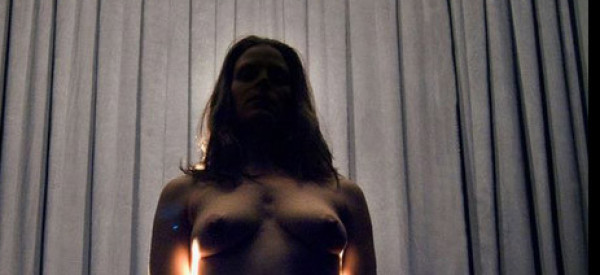The pioneers of feminist performance art from 1965-1975 used the female body to strive for authenticity, in art and in life. Dancer/choreographer Anne Juren and director Annie Dorsen aren't too interested in staying with the party line, however.
To address the contradictions in contemporary feminism, Durer and Juren rip open iconic historical moments and subvert them. Instead of seeking authenticity, the two artists invite illusion. And that's how the canon of feminist performance was recontextualized as a magic show.
"Magical" is a contemporary collaboration drawing influence from famous works of art like Martha Rosler’s "Semiotics of the Kitchen," Yoko Ono’s "Cut Piece," Marina Abramović’s "Freeing the Body" and Carolee Schneemann’s "Interior Scroll" and "Meat Joy." The piece combines theater, dance, magic tricks and rock music while questioning the validity of the disciplines.
See a preview of the show below and scroll down for our interview with director Annie Dorsen.
Magical Teaser from Performance Space 122 on Vimeo.
HP: What are some contradictions in contemporary feminism?
AD: The older generation of artists, they were full of wit, playfulness, satire when dealing with the big wigs of male dominated art history. And yet they seem a little bit essentialist to us. There is a female way of knowing, a female authenticity, a connection to nature.
My generation more or less rejects that notion, at least i do. When you strip it down you don't find the authentic, you find more culture. Stripping off language and clothing, you end up with the vagina, which is more culture. You get technology, you get fashion, you get a technology of knowing and a technology of being. The next generations don't appreciate the struggles. They don't appreciate how different things were.
What I find looking around in pop culture and social culture is some idea of what we really want is to self-exploit and to self-objectivize. All of these are questions, and that is one of the contradictions. We have inherited certain ways of thinking about the female body as something that does something in the world. The body is not supposed to be in battle anymore. What do we really know about it and what have we really inherited? How many performances are there where we take our clothes off-- what is the fascination with that, still? Why is that a right of passage? What kind of liberation does that propose?

HP: What drew you to Anne Juren's work?
AD: I would say both of us are drawn to escaping our own home disciplines. She was very interested in theater, and thinking of theater as a material choreography. I am super interested in escaping my training as a theater artist. Can theater be ready made? objectified? We met a little bit in the middle with having super big interests in the protocol of choreography and performance art.
HP: How did you two meet and become involved in the project?
AD: We actually met for the first time now almost 7 years ago at performing arts forum. We met then but we got back in touch in early 2010 for another project. Anne was invited to expand an individual project into a full length piece, rethinking it and opening it up. The theme explored question of fashion and the idea of illusion and transformation. It was a 15 minute piece. She had this one tiny section that played with Carolee [Schneemann] and used some magic tricks. When we were brainstorming we threw away everything except that one image.

For 'Magical,' How did you choose the performance artists to subvert?
HP: It was kind of hit or miss. We played around with trying to recreate these older, golden moments in feminist performance. There was a big exhibit of feminist art at the Pomipdou, "Elle." We had the catalogue from it and were struck by connections amongst the different artists. We were thinking about what connections we wanted to draw between pieces, vibes and our way of looking at the works. What is our generation of female artists and how do we look at the female body, at the contradictions?
HP: Without giving anything away, do you have a favorite moment in the performance?
AD: My favorites are always the tiny moments-- these little things you get fixated on. This time it is shaking. Marina [Abramovic] was trying to put herself in some kind of trap and basically shook for 6 hours and she eventually passed out. She was exploring rhythm, going into a transe, losing yourself, getting out of your own head, etc. We do a truncated version of the piece and right when the dancer is starting to lose herself, she scratches her ribs, right under her chest. All of the sudden, the subjectvity of our body is right back there and in that moment the illusion of being able to free yourself is questioned.
In the Carolee [Schneeman] section a women pulls magic scarves, batteries and a video out of her vagina. We have a schizophrenic relationship with pieces like this. Sometimes I think it's essentialist, didactic and first level. Then the next day and I'll find them so sly, so knowing, so full of wit. And I'm impressed all over again. It sort of ricochets. Sometimes I am critical and sometimes I am really impressed and finding more and more in them.
Anne and I took a big leap moving from these ideas of transparency and putting the theater back in. It's almost cruel, almost an act of violence. There was something utopian about their ideas, re-investing art with a DIY communal power. We put it on a stage with lights and rock music. We put all this skill back in and a little bit of flash and a different kind of humor. It's generational in a certain way.
We now think we are stuck in the circle, but maybe we can open up a space for questioning. We no longer have the bold idea that we can remake the entire system.
"Magical" by Annie Dorsen and Anne Juren shows January 15, 17, 18 at 7:30pm and January 19 at 6pm at New York Live Arts, as part of the COIL festival.
